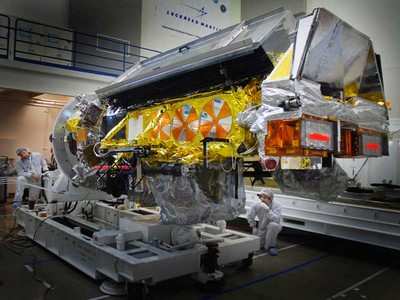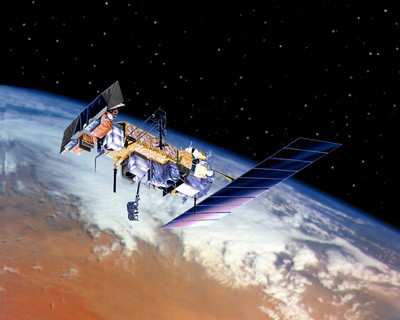Launch Scheduled In February 2009
The latest polar-orbiting operational environmental weather
satellite developed by NASA for the National Oceanic and
Atmospheric Administration, called NOAA-N Prime, arrived Tuesday by
C-5A military cargo aircraft at Vandenberg Air Force Base, CA in
preparation for a Feburary 4, 2009, launch.

NOAA-N Prime, built by Lockheed Martin, is similar to NOAA-N
launched on May 20, 2005. The satellite will be launched from the
Western Range at Vandenberg AFB by a United Launch Alliance
two-stage Delta II rocket managed by NASA's Launch Service Program
at the Kennedy Space Center, FL.
The satellite is the latest in the Advanced Television Infrared
Observational Satellites -N series built by Lockheed Martin Space
Systems Company. NOAA-N Prime will provide a polar-orbiting
platform to support environmental monitoring instruments for
imaging and measuring the Earth's atmosphere, its surface and cloud
cover, including Earth radiation, atmospheric ozone, aerosol
distribution, sea surface temperature, and vertical temperature and
water profiles in the troposphere and stratosphere. The satellite
will assist in measuring proton and electron fluxes at orbit
altitude, collecting data from remote platforms and will assist the
Search and Rescue Satellite-Aided Tracking system.
NOAA-N Prime will be prepared for launch in a NASA payload
processing facility located on north Vandenberg AFB. On November 5,
the satellite will be removed from its shipping container and
rotated from the horizontal to vertical position. Spacecraft
systems testing and launch preparations will then begin, which will
take about a month.
Meanwhile, at the launch pad, the rocket that will launch NOAA-N
Prime is a Delta II 7320 manufactured and prepared for launch by
the United Launch Alliance. The first stage is scheduled to be
erected on Space Launch Complex 2 on December 2. The three strap-on
solid rocket boosters will be raised and attached to the booster
the following day.
The second stage, which burns hypergolic propellants, will be
hoisted atop the first stage on December 4. The fairing which will
surround the spacecraft will then be hoisted into the clean room of
the mobile service tower. The following week, as a leak check, the
first stage will be loaded with liquid oxygen during a simulated
countdown. The following day, a simulated flight test will be
performed simulating the vehicle's post-liftoff flight events
without fuel aboard. The electrical and mechanical systems of the
entire Delta II will be exercised during this test.

In mid-January, the NOAA-N Prime spacecraft will be hoisted atop
the Delta II at the launch pad. The following week, a final major
test is then ready to be conducted, which will involve the Delta II
and NOAA-N Prime working together. This will be a combined minus
count and plus count, simulating all events as they will occur on
launch day, but without propellants aboard the vehicle.
Finally during the last week of January, the fairing will be
installed around the spacecraft.
 ANN's Daily Aero-Linx (05.02.24)
ANN's Daily Aero-Linx (05.02.24) ANN's Daily Aero-Term (05.02.24): Touchdown Zone Lighting
ANN's Daily Aero-Term (05.02.24): Touchdown Zone Lighting Aero-News: Quote of the Day (05.02.24)
Aero-News: Quote of the Day (05.02.24) ANN FAQ: Contributing To Aero-TV
ANN FAQ: Contributing To Aero-TV NTSB Final Report: Cirrus Design Corp SR20
NTSB Final Report: Cirrus Design Corp SR20




